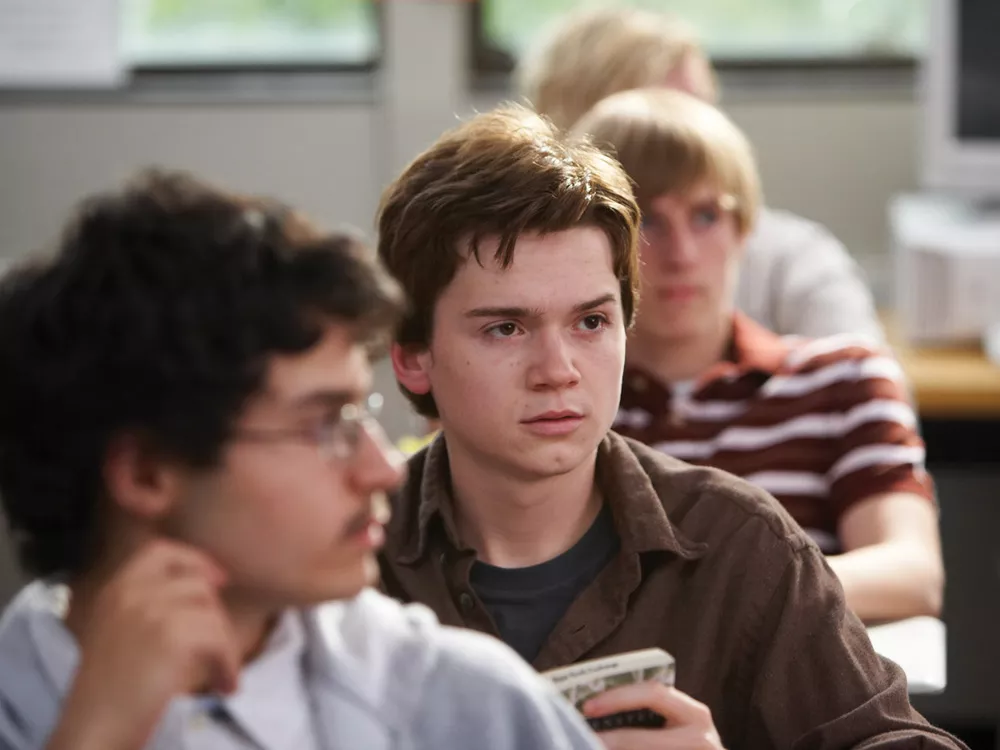If Norman were a real boy, he would attend high school at Lewis and Clark. He lives in a stately but neglected white house just off Rockwood Boulevard. It is neglected because his dad has cancer, does not work and cannot afford to maintain it. Norman’s mother is already dead. Norman himself is seriously considering suicide. Not long after we meet him, he pushes a knife into the meat below his clavicle. He draws blood, then stops.
If Norman were a real boy, Mr. Angelo — who teaches a class that seems to be a lower-division survey on getting by — may not have correctly identified his anti-social behavior as a protective shell around a latent and prodigious imagination.
If Norman were a real boy, his redemption would not be
sweeping or CinemaScopic. It would probably not come at the hands and in
the smile of Emily, the beautiful new girl, who also sees something in
the way his sullenness percolates with destructive creativity. In real
life, Norman’s road toward mental health would probably require a decade
of therapy following a failed marriage and maybe a drug problem. It
would take time.
But Norman is not a real boy. He is a character in a thoughtful, sometimes-hard-to-watch film from the young director Jonathan Segal. Played with intensity by Dan Byrd, Norman only has an hour-and-a-half to get his shit together and learn something about himself. Ninety-seven minutes, to be exact.
Because Norman isn’t a real boy, geography can serve story. And so, every day, Norman gets a ride from his friend James, down Rockwood to McClellan, then presumably over to Washington where they head off the South Hill and then north into the Emerson/Garfield neighborhood. He goes to high school at North Central — or a fictional school made up of NC’s theater and its halls and the broad lawn that fronts Washington Street.
If Norman went to high school in a place like Lewis and Clark — a peerless example of early-century architecture — it would suggest his story is exceptional. Placing him at North Central, with its broad, flat, almost bureaucratic design, suggests Norman is a tale that could happen anywhere.
While scouting Spokane with North by Northwest, the local production company that filmed Norman in 2008, Segal says he was looking for locations that evoked “Anytown, America.” The team looked at six schools, by his count, before deciding on NC.
Anytown is represented in casting choices as well. Emily, the pretty girl, symbolic of interpersonal tranquility and second chances, is played by Emily Van Camp, who currently spends her time wallowing in murder fantasies in the slickly shot Revenge on ABC. Dirty blond with a placid smile, she has an all-American face. Her home onscreen is a large craftsman near Cliff Park.
The character actor Richard Jenkins is a quintessential Baby-Boomer-as-father-figure. Pockmarked and expressive of face, he spends his final days trying to enjoy life with his son. Dad wants to protect Norman from the pain of his death without preparing him adequately for it. His oncologist works at Deaconess.
Norman himself is the outlier. More angry than sad for
most of the film, he hides his emotions from everyone. One day, when
James asks him why he is such a flake, he tells a monstrous lie, which
Emily overhears. It catalyzes their romance, but Norman makes the
mistake of thinking that the lie is the reason for it. This mistake
propels the film.
You probably know Dan Byrd, from Cougar Town, the Courtney Cox vehicle on ABC. He plays a teenager there too. Well, “I think they let my character turn 20 this year,” he says. In any event, you have never seen him like this.
Norman is far darker than other characters Byrd has played. He does monstrous things to maintain the facade of normalcy he has built. “This was one of the first real acting jobs I ever had,” Byrd says. He made the most of it.
On the surface, the film seems to be about a very strange, messed-up kid in very normal surroundings. The comfortable conclusion is that this kid, Norman, is alien to the American experience. The best thing Segal and Byrd do — and do subtly, with landscape and expression and conversation rather than grand soliloquies — is convince us of the opposite.
Controlling and isolationist, Norman is very much a part of us, the part we don’t like to admit exists.

